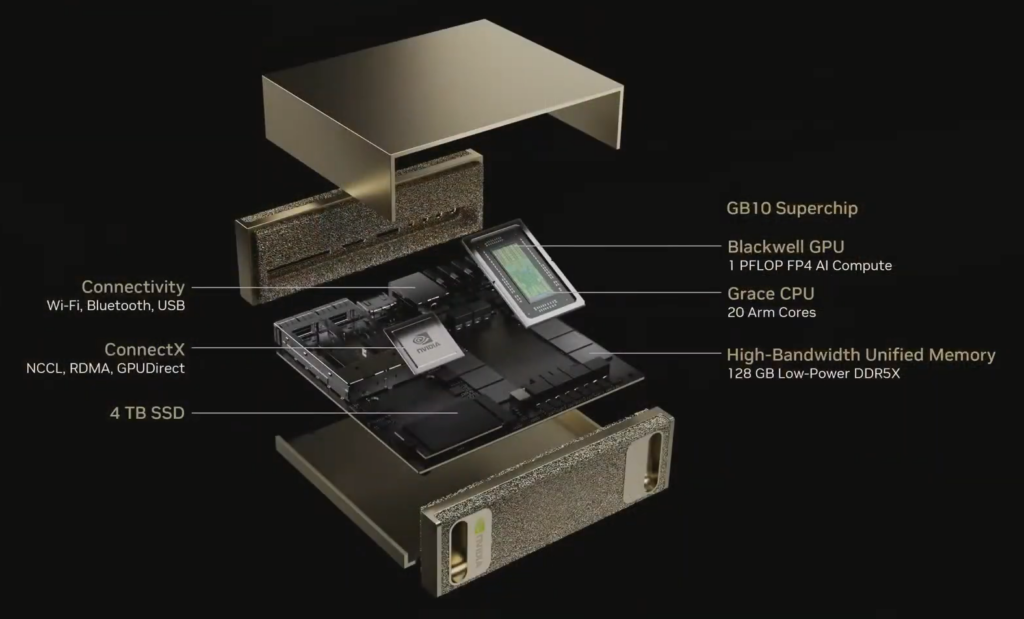At the Consumer Electronics Show (CES) 2025 in Las Vegas, Nvidia CEO Jensen Huang introduced Project Digits, a personal AI supercomputer designed to democratize access to advanced AI capabilities. Set for release in May, Project Digits starts at $3,000, making high-performance AI computing more accessible to individual developers, researchers, and students.
Cutting-Edge Technology with Grace Blackwell Superchip
The compact system is powered by Nvidia’s new GB10 Grace Blackwell Superchip, delivering up to 1 petaflop of AI performance. This enables the handling of sophisticated AI models with up to 200 billion parameters, all within a desktop-sized device that operates from a standard power outlet. For more demanding applications, users can link two Project Digits systems to support models with up to 405 billion parameters.
Each Project Digits unit comes equipped with 128GB of unified memory and up to 4TB of NVMe storage, ensuring ample capacity for extensive AI workloads. The system runs on a Linux-based Nvidia DGX OS and supports popular frameworks like PyTorch, Python, and Jupyter notebooks, facilitating seamless integration into existing AI development workflows.
The GB10 Superchip features Nvidia’s latest-generation CUDA cores and fifth-generation Tensor Cores … Developed in collaboration with MediaTek, this architecture optimizes power efficiency and performance, enabling the supercomputer to deliver exceptional AI processing capabilities within a compact form factor.
Bringing AI Power to Every Desk

Users will have access to Nvidia’s extensive AI software library, including development … This comprehensive software ecosystem empowers developers to fine-tune models using the … .
Project Digits also offers seamless integration with cloud services and data center infrastructure, allowing users to develop and test AI models locally before deploying them at scale. This flexibility ensures that developers can maintain consistency across different environments, leveraging the same Grace Blackwell architecture … throughout the development process.
Nvidia’s announcement of Project Digits reflects the company’s commitment to making AI technology more accessible and affordable. By placing a powerful AI supercomputer on the desks … individual users, Nvidia aims to empower a new generation of innovators to engage with and shape the future of AI.
In addition to Project Digits, Nvidia unveiled other significant advancements at CES 2025. The company introduced the RTX 50 Series gaming graphics cards, utilizing the new Blackwell architecture to deliver enhanced performance and AI-driven graphics rendering. These GPUs promise movie-like graphics with advanced shading features, marking a substantial leap in gaming technology.
Furthermore, Nvidia launched Cosmos, a family of AI models designed to generate photorealistic video for training robots and autonomous vehicles. By providing more cost-effective and efficient training solutions, Cosmos aims to accelerate the development of intelligent machines capable of navigating complex real-world environments.
A Vision for Democratizing AI
Nvidia’s strategic partnerships also featured prominently at CES 2025. The company announced a collaboration with Toyota, which plans to incorporate Nvidia’s Orin chips and software into several vehicle models to enhance advanced driver assistance systems. This partnership underscores Nvidia’s expanding influence in the automotive sector, with projected automotive revenue expected to reach $5 billion in fiscal 2026.
As Nvidia continues to push the boundaries of AI and computing technology, the introduction of Project Digits represents a significant milestone in making powerful AI tools accessible to a broader audience. By lowering the barriers to entry, Nvidia is fostering an environment where innovation can thrive, enabling individuals and organizations to harness the transformative potential of AI across various industries.














